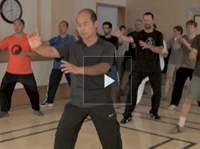“Three” represents a loop, means to repeat things endlessly.
There is really only two main things in Chinese martical arts: horizontal and vertical.
We need to determine horizontal and vertical, one of them is more dominant.
However, you need both of them to be present to say that there is either horizontal or vertical. We need to both to make the distinction.
We need to determine the opponent’s primary move, and use the opposite to deal with it.
The vertical motion will cause a very weird feeling to the opponent when done correctly. It is like the opponent will fall into the hole. In our normal life, we try to escape from the vertical motion, and only do the horizontal motion, which becomes much more familar to us. With Practical Method, we train to have the vertical motion, and also to get use to it, so that we are not afraid of it ourselves.
Yao 摇 – horizontal
Bai 摆 – vertical
Exercise:
-
- Raise the elbow above the shoulder, press it down to scoop/dig.
- Vertical movement is controlled by kua and knee (bottom half of the body).
- Hand/arm movement is always considered to be in the horizontal dimension.
- The waist rotation is used to coordinate/integrate the upper body horizontal and the lower body vertical movements together.
- Ultimately, we need to use the kua to drive the overall movement. The other parts are just adjustments or adaptations.
Bie (别)
You need one pair of yin-yang to bie zhu (别住)/twist-and-lock. This pair is typically on the upper body, e.g. with arms and chest. The 2nd pair of yin-yang is by the lower body, e.g. with front kua and rear knee, to bie kai (别开)/twist-and-open. The two pairs intersect and share the same non-moving dot, like the rivot in a pair of scissors.
Exercise:
- Use a stick with a heavy load at the outer end (heavy end).
- Use the forward wrist under the stick as a pivot.
- Use the backward hand to the inner end of the stick (handle end). Pump down this end of the stick to tilt up the heavy end.
- Start the pivot in the middle of the stick, and gradually move it closer to the handle end. This will increase the difficulty as the pivot gets closer to the handle end.
- The key is to keep the pivot not moving.
- We can only really train the bie power with a load that is just heavy enough to not allow us to tilt it at first. The result of the training is an ability to transmit power from one end of the stick to the other end. It’s best to training with the white wax wood, which is bendable.
Weapon Training
In sword and broadsword training, we need to move the weapson with a non-moving dot on the blade.
In 风卷残云 of broadsword, the blade does not move, the body moves forward.


